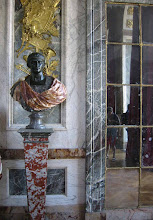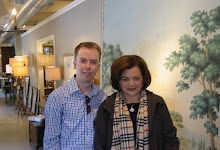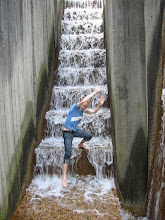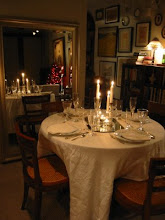 The Pan American Building was completed in 1910 with a very prominent start; Paid for by Andrew Carnegie, opened by President Taft and with President Theodore Roosevelt as the biggest advocate of the organization. While the building kick-started Paul Cret's burgeoning career as his first major commission, it has fallen into relative obscurity.
The Pan American Building was completed in 1910 with a very prominent start; Paid for by Andrew Carnegie, opened by President Taft and with President Theodore Roosevelt as the biggest advocate of the organization. While the building kick-started Paul Cret's burgeoning career as his first major commission, it has fallen into relative obscurity. According to the historian Marjorie Ingle, the design of this building jump started the Mayan Revival which was popular shortly after 1910 until the early 1930s. How many buildings can boast of starting a fad or entire style? (Gehry's Guggenheim in Bilbao comes to mind)
According to the historian Marjorie Ingle, the design of this building jump started the Mayan Revival which was popular shortly after 1910 until the early 1930s. How many buildings can boast of starting a fad or entire style? (Gehry's Guggenheim in Bilbao comes to mind) Cret studied at the Ecole des Beaux Arts in Paris and you can clearly see the influence in the Pan American Building. While the white marble form is clearly Beaux-Arts style, the details are something that was quite new and maybe a bit odd. They are inspired by the different traditional styles from South America such as Mayan and Aztec (although seen through a French man's eyes).
Cret studied at the Ecole des Beaux Arts in Paris and you can clearly see the influence in the Pan American Building. While the white marble form is clearly Beaux-Arts style, the details are something that was quite new and maybe a bit odd. They are inspired by the different traditional styles from South America such as Mayan and Aztec (although seen through a French man's eyes). However, much of the other detailing is neoclassical and very traditional, expected for the style, such as the figures seen below in the cornice and pilaster capitals. This mix is what makes the building so utterly fabulous in my opinion.
However, much of the other detailing is neoclassical and very traditional, expected for the style, such as the figures seen below in the cornice and pilaster capitals. This mix is what makes the building so utterly fabulous in my opinion. The rear of the building faces a garden with a central pool. A library was located on the main level (prescribed by Carnegie of course) which opened out onto the garden with the grand ballroom seen above it through large arched windows.
The rear of the building faces a garden with a central pool. A library was located on the main level (prescribed by Carnegie of course) which opened out onto the garden with the grand ballroom seen above it through large arched windows. In Beaux-Arts tradition, the floorplan is the starting point of the design and really is the focal point. Architecture schools today, at least here in the US, still teach based on this beaux-arts method with a diagram which ultimately becomes the (modified) floorplan.
In Beaux-Arts tradition, the floorplan is the starting point of the design and really is the focal point. Architecture schools today, at least here in the US, still teach based on this beaux-arts method with a diagram which ultimately becomes the (modified) floorplan.  Here in the Pan American building, there is a central entry point, the foyer seen above, with a long grand procession up stairs flanking an open courtyard, culminating at the main space, the ballroom.
Here in the Pan American building, there is a central entry point, the foyer seen above, with a long grand procession up stairs flanking an open courtyard, culminating at the main space, the ballroom.  The essential purpose of this building was entertaining. Therefore, the floorplan follows this diagram precisely with all of the other functions such as offices and the library being worked in around this core. The building was designed around guests arriving for a party or lecture in the ballroom.
The essential purpose of this building was entertaining. Therefore, the floorplan follows this diagram precisely with all of the other functions such as offices and the library being worked in around this core. The building was designed around guests arriving for a party or lecture in the ballroom.
As I mentioned Saturday, all of the 'stonework' in the entry is faux - molded plaster. It had many of us fooled! Imagine all of the work that went into the walls being shaped into stone 'blocks', not to mention the garlands of leaves, pilasters, brackets, cornices and all of the other details. The columns at either end of the foyer are marble with bronze capital and bases. Here we have one of the grand stairs (the other is identical) which lead one from the foyer to the ballroom on the Piano Nobile above. Notice the wood beamed ceiling above the staircase and those beautiful bronze sconces.
Here we have one of the grand stairs (the other is identical) which lead one from the foyer to the ballroom on the Piano Nobile above. Notice the wood beamed ceiling above the staircase and those beautiful bronze sconces.
 Even the smallest details were custom designed by Cret and his staff, such as these access ropes at the foot of the staircase. Rather than a plain hook, there is a Mayan figure to hold the rope back! You can see the faux plasterwork a little better here. Even the rope is gorgeous!
Even the smallest details were custom designed by Cret and his staff, such as these access ropes at the foot of the staircase. Rather than a plain hook, there is a Mayan figure to hold the rope back! You can see the faux plasterwork a little better here. Even the rope is gorgeous!
 The courtyard is the focal point of the building's circulation area. It has a retractable glass ceiling(no longer operating) and is open to the foyer and all of the stairs and hallways in the building. The materials are more durable in this space, such as the terracotta freize which runs underneath the wood cornice and brackets of the roof overhang.
The courtyard is the focal point of the building's circulation area. It has a retractable glass ceiling(no longer operating) and is open to the foyer and all of the stairs and hallways in the building. The materials are more durable in this space, such as the terracotta freize which runs underneath the wood cornice and brackets of the roof overhang.
 The tree on the left was actually planted by President Taft at the opening of the building: grafting together two species of trees, one from South and the other from North America.
The tree on the left was actually planted by President Taft at the opening of the building: grafting together two species of trees, one from South and the other from North America. The fabulous central marble fountain was sculpted by Gertrude Vanderbilt Whitney and features Aztec figures with eyes which light up!
The fabulous central marble fountain was sculpted by Gertrude Vanderbilt Whitney and features Aztec figures with eyes which light up!
 More of the beautiful glazed terracotta work below depicting maps of the Americas and doves of peace: Peace being the organization's mission.
More of the beautiful glazed terracotta work below depicting maps of the Americas and doves of peace: Peace being the organization's mission. Below you can see the glass roof over the terracotta tiles.
Below you can see the glass roof over the terracotta tiles. The polychrome wood brackets are really stunning and add a lot of color to the terracotta and beige plaster.
The polychrome wood brackets are really stunning and add a lot of color to the terracotta and beige plaster. I thought this tiled water fountain, located behind the courtyard was really fantastic!
I thought this tiled water fountain, located behind the courtyard was really fantastic!
 Here we are at the top of the stairs looking down at the foyer. The building opens up even further on the 2nd floor, with office suites opening off the corridors you see running alongside the staircase.
Here we are at the top of the stairs looking down at the foyer. The building opens up even further on the 2nd floor, with office suites opening off the corridors you see running alongside the staircase.  The main hall upstairs is known as the 'Hall of Heros' and is lined with 50 busts which were given by countries in the organization. George Washington was chosen by the US and is located prominently in the center.
The main hall upstairs is known as the 'Hall of Heros' and is lined with 50 busts which were given by countries in the organization. George Washington was chosen by the US and is located prominently in the center.
 Flags of the members also line the hall.
Flags of the members also line the hall.  The main ballroom, or 'Hall of the Americas', opens off the 'Hall of Heros' through 5 large doorways, mirrored 65feet across by the arched windows to the garden below and is lit by 3 enormous crystal chandeliers. A meeting was in session during our tour.
The main ballroom, or 'Hall of the Americas', opens off the 'Hall of Heros' through 5 large doorways, mirrored 65feet across by the arched windows to the garden below and is lit by 3 enormous crystal chandeliers. A meeting was in session during our tour.
 Here we have one of the grand stairs (the other is identical) which lead one from the foyer to the ballroom on the Piano Nobile above. Notice the wood beamed ceiling above the staircase and those beautiful bronze sconces.
Here we have one of the grand stairs (the other is identical) which lead one from the foyer to the ballroom on the Piano Nobile above. Notice the wood beamed ceiling above the staircase and those beautiful bronze sconces. Even the smallest details were custom designed by Cret and his staff, such as these access ropes at the foot of the staircase. Rather than a plain hook, there is a Mayan figure to hold the rope back! You can see the faux plasterwork a little better here. Even the rope is gorgeous!
Even the smallest details were custom designed by Cret and his staff, such as these access ropes at the foot of the staircase. Rather than a plain hook, there is a Mayan figure to hold the rope back! You can see the faux plasterwork a little better here. Even the rope is gorgeous! The courtyard is the focal point of the building's circulation area. It has a retractable glass ceiling(no longer operating) and is open to the foyer and all of the stairs and hallways in the building. The materials are more durable in this space, such as the terracotta freize which runs underneath the wood cornice and brackets of the roof overhang.
The courtyard is the focal point of the building's circulation area. It has a retractable glass ceiling(no longer operating) and is open to the foyer and all of the stairs and hallways in the building. The materials are more durable in this space, such as the terracotta freize which runs underneath the wood cornice and brackets of the roof overhang. The tree on the left was actually planted by President Taft at the opening of the building: grafting together two species of trees, one from South and the other from North America.
The tree on the left was actually planted by President Taft at the opening of the building: grafting together two species of trees, one from South and the other from North America. The fabulous central marble fountain was sculpted by Gertrude Vanderbilt Whitney and features Aztec figures with eyes which light up!
The fabulous central marble fountain was sculpted by Gertrude Vanderbilt Whitney and features Aztec figures with eyes which light up!
 More of the beautiful glazed terracotta work below depicting maps of the Americas and doves of peace: Peace being the organization's mission.
More of the beautiful glazed terracotta work below depicting maps of the Americas and doves of peace: Peace being the organization's mission. Below you can see the glass roof over the terracotta tiles.
Below you can see the glass roof over the terracotta tiles. The polychrome wood brackets are really stunning and add a lot of color to the terracotta and beige plaster.
The polychrome wood brackets are really stunning and add a lot of color to the terracotta and beige plaster. I thought this tiled water fountain, located behind the courtyard was really fantastic!
I thought this tiled water fountain, located behind the courtyard was really fantastic!
 Here we are at the top of the stairs looking down at the foyer. The building opens up even further on the 2nd floor, with office suites opening off the corridors you see running alongside the staircase.
Here we are at the top of the stairs looking down at the foyer. The building opens up even further on the 2nd floor, with office suites opening off the corridors you see running alongside the staircase.  The main hall upstairs is known as the 'Hall of Heros' and is lined with 50 busts which were given by countries in the organization. George Washington was chosen by the US and is located prominently in the center.
The main hall upstairs is known as the 'Hall of Heros' and is lined with 50 busts which were given by countries in the organization. George Washington was chosen by the US and is located prominently in the center. Flags of the members also line the hall.
Flags of the members also line the hall.  The main ballroom, or 'Hall of the Americas', opens off the 'Hall of Heros' through 5 large doorways, mirrored 65feet across by the arched windows to the garden below and is lit by 3 enormous crystal chandeliers. A meeting was in session during our tour.
The main ballroom, or 'Hall of the Americas', opens off the 'Hall of Heros' through 5 large doorways, mirrored 65feet across by the arched windows to the garden below and is lit by 3 enormous crystal chandeliers. A meeting was in session during our tour.













































































































16 comments:
Holy cow, this building is INSANE! When I only saw the picture of the ballroom ceiling, I thought it needed color, but seeing the whole room with those curtains, I get it now. This is an outrageously beautiful building! Great photographs as well!
Wonderful tour of an incredible building. The attention to detail is amazing. Reggie
Dear AD, What a fascinating 'tour' of this extraordinary building in which you have included so much in the way of detail which otherwise might have been overlooked. What you say here of the purpose of the building determining both the lay out and the finer points of design makes complete sense, helping one to realise, in this instance as well as others, why things are as they are.
What a delightful post! The detail is fascinating. I do think the light up eyes in the fountain are a little creepy, did you see them lit?
Believe it or not, I had never heard of Paul Cret before. The building is very surprising. The back looks very much like one of the museums in Rome (Villa Borghese?)
The detailing shows once more that the concept of acculturation is central to architecture!
http://davidikus.blogspot.com/
Love it love it! Your photos are amazing! With your description it feels like I am there!
kerry, the eyes don't light up anymore, either unfortunately -but you can see they are colored glass.
I'm so glad everyone has enjoyed it!!
We're right there with you on this wonderful tour. I love your own attention to detail and the great commentary. I see so many new buildings where detail seems to be a last-minute add-on, rather than something intrinsic to the design. Thanks, AD! ... Mark
Definitely enjoyed the in-depth tour! Happy to learn more about Mayan Revival and the South American influences.
So great to see this amazing building. Love seeing a wonderful place that I have never seen before. Thanks!
Stefan, as usual an incredible tour & commentary. I repeat...your blog postings are an education. Love them.
xs
Wow! It is so grand. i love it. I'd be thrilled to walk through that courtyard. Thanks for the tour.
I just LOVE seeing all these photos!!!!
Mayan Beaux Arts - fascinating, and why not? A bit like what Lutyens was doing in Delhi.
That building is also home to the world's longest mural. it adorns a restricted underground passageway that goes to another building on the next block.
This is the good blog with good images and good details. Please keep on posting the more stuff. I will like to hear more from you.
Post a Comment